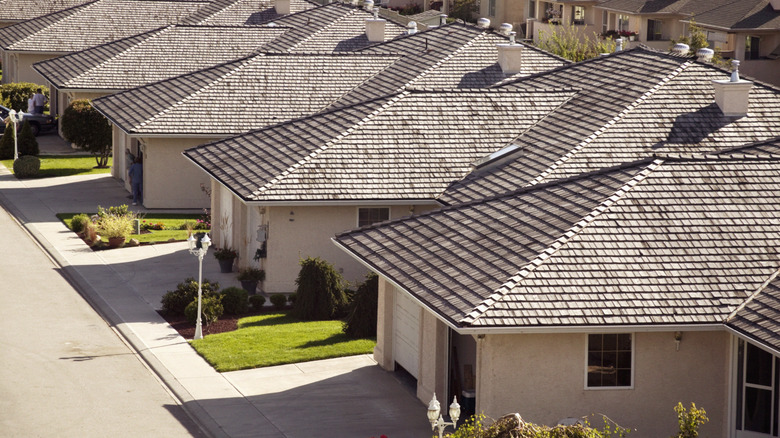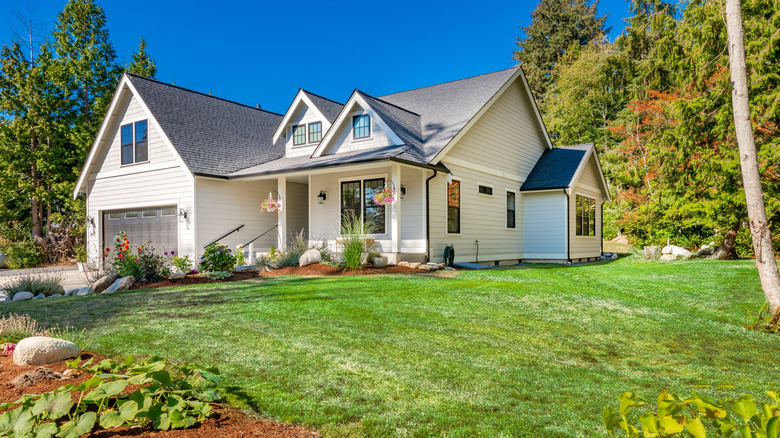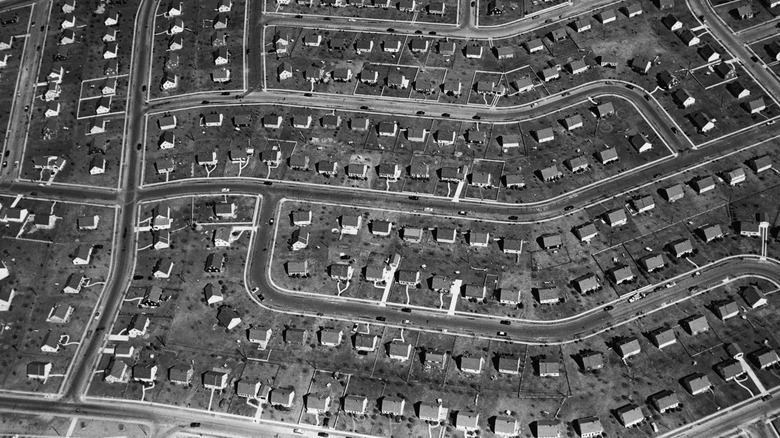Why Are Homes In New Neighborhoods Being Built To Look So Similar To Each Other?
New homes are being built at a fast clip in certain U.S. cities, and as these cities expand to meet the growing demand for housing, you may notice that many houses in new neighborhoods, and even apartment buildings, look strikingly similar, if not downright identical. These "copy-and-paste" neighborhoods may give off an overly curated vibe, and while the aesthetics are meant to appeal to a wide demographic of potential buyers, there are several other reasons behind the uniform construction of these new homes. It's not unlike the post-World War II boom of tract houses, when growing demand created these strategies of designing neighborhoods.
One of the primary reasons for said strategy, then and now, is a simple economy of scale. If builders can standardize house production, they can mass produce the same house quite quickly. As labor, materials, and design are consistent variables, it's a more efficient way to plan for and then recoup costs. Standardization, thus, can keep up with the incredible demand on the market, without breaking the bank too much for either the builder or the eventual buyer.
However, cost isn't the only factor that drives these cookie-cutter homes in standardized neighborhoods. Another practical reason is to make it easier for developers to follow planning and zoning regulations and restrictions. Getting approval for one home is complicated enough, but standardized plans for a number of tract homes means approvals can be given on a larger scale, whether it be building permits or approved materials. Having an approved design that can be widely reproduced with slight variations cuts down on production time, too, so these houses can hit the market sooner for eager buyers.
How to make your tract home more unique
While there's nothing wrong with standardization, (in fact, there are some expertly designed neighborhoods out there that'll convince you to live there) some buyers want something more unique. However, budgets and location might limit the accessibility of what they're looking for. Purchasing a tract home is not the end of your design dreams, though, and there are many ways you can customize these houses without breaking the bank. That's the benefit of buying a new construction home – look at it as a blank canvas for your own tastes. When it comes to the exterior — the most obvious part of the home that resembles others on your block — you can add your own touch by painting exterior details. Start by talking to your HOA about what options you have: for example, what colors can you paint your door? Can you add any landscaping details? Many complexes are happy to consider additions that will beautify a home.
In terms of the interior, you can make it your own with some easy changes. This includes swapping out hardware and light fixtures in the kitchen and bathrooms to suit your style more. You can also take some paint to the rooms or add wallpaper to introduce color, texture, or visual appeal that the otherwise basic floorplan and design lacks. Also, don't underestimate the power of fun furniture design and contrasting colors add to the architectural features of the space — you can make a room look entirely different from your neighbors' by leveraging statement pieces and distinct styles: try accenting with special antique and flea market finds, or leaning into your favorite jewel-toned hues to create a unique space.
A brief history of tract homes
With the uptick of new builds, it feels like these standardized blocks of homes are part of a modern strategy, but like we mentioned before, the idea of tract homes was borne out of a major housing need in the 1940s. Translating the idea of standardization from other industries, like the automotive manufacturing industry, builders systematically crafted large swaths of homes to meet a demand for middle-class priced houses. By 1945, an influx of GIs and their families were looking for their forever home within a certain budget, and by 1948, builders like Levitt and Sons on Long Island, New York, were building 30 houses per day to meet said demand.
This phenomenon has continued into the present day, with efficient, minimalist, simple facades and open floor plans reigning supreme among contemporary housing complexes. While style fads have changed, the general concept of cheap-to-build, mass-produced houses remains extremely popular, especially in middle-class neighborhoods.
There's a long history of uniform housing developments, and throughout the decades homeowners have been able to make their tract house, a home. With a few personal touches, you can make your new-build house more personal to you too, while meeting budget requirements. Developers get a "good deal," and you have the foundations of your perfect home as a result.


